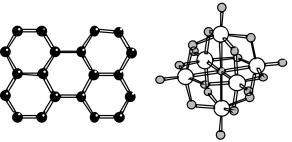The preparation, structures and physical properties of the organic/inorganic radical salts based upon perylene (per) and Lindquist type polyoxometalates (POMs) are reported. Three new hybrid salts have been prepared: (per)5[Mo6O19]
(1), (per)5[W6O19]
(2), and (per)5[VW5O19]
(3). Only structures 1
(P![[1 with combining macron]](https://www.rsc.org/images/entities/char_0031_0304.gif) , Z = 2) and 3
(P
, Z = 2) and 3
(P![[1 with combining macron]](https://www.rsc.org/images/entities/char_0031_0304.gif) , Z = 2) were fully determined as compound 2 was found to have unit cell parameters practically identical to 1 and, therefore, is considered isostructural with the latter. The structures consist of interpenetrated organic and mixed organic/inorganic layers in the ac plane alternating along the a direction. The organic layers present a novel packing mode of the perylene molecules that consists of criss-cross chains formed by two alternating dimers running along the c axis. Besides the ability to induce novel packings in the organic sublattice, the possibility offered by the POMs of varying the charge while maintaining the size and shape of the anion has enabled the control of the electronic band filling and, therefore, of the electrical and magnetic properties. Thus, salts 1 and 2, where the anionic charge is −2, are diamagnetic and present lower room temperature conductivities, while salt 3, where the anionic
charge is −3, has an unpaired electron and presents a higher room temperature conductivity and a lower activation energy. Thermopower measurements show that salts 1 and 2 present hole-type conduction whereas salt 3 exhibits electron-dominating electrical transport.
, Z = 2) were fully determined as compound 2 was found to have unit cell parameters practically identical to 1 and, therefore, is considered isostructural with the latter. The structures consist of interpenetrated organic and mixed organic/inorganic layers in the ac plane alternating along the a direction. The organic layers present a novel packing mode of the perylene molecules that consists of criss-cross chains formed by two alternating dimers running along the c axis. Besides the ability to induce novel packings in the organic sublattice, the possibility offered by the POMs of varying the charge while maintaining the size and shape of the anion has enabled the control of the electronic band filling and, therefore, of the electrical and magnetic properties. Thus, salts 1 and 2, where the anionic charge is −2, are diamagnetic and present lower room temperature conductivities, while salt 3, where the anionic
charge is −3, has an unpaired electron and presents a higher room temperature conductivity and a lower activation energy. Thermopower measurements show that salts 1 and 2 present hole-type conduction whereas salt 3 exhibits electron-dominating electrical transport.
![[1 with combining macron]](https://www.rsc.org/images/entities/char_0031_0304.gif) , Z = 2) and 3
(P
, Z = 2) and 3
(P![[1 with combining macron]](https://www.rsc.org/images/entities/char_0031_0304.gif) , Z = 2) were fully determined as compound 2 was found to have unit cell parameters practically identical to 1 and, therefore, is considered isostructural with the latter. The structures consist of interpenetrated organic and mixed organic/inorganic layers in the ac plane alternating along the a direction. The organic layers present a novel packing mode of the
, Z = 2) were fully determined as compound 2 was found to have unit cell parameters practically identical to 1 and, therefore, is considered isostructural with the latter. The structures consist of interpenetrated organic and mixed organic/inorganic layers in the ac plane alternating along the a direction. The organic layers present a novel packing mode of the 

 Please wait while we load your content...
Please wait while we load your content...